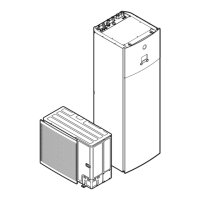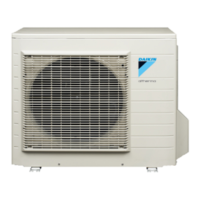Do you have a question about the Daikin ERLA11DAV3 and is the answer not in the manual?
Explains the meaning of various danger, warning, caution, notice, and information symbols used.
Outlines general safety instructions and regulations specifically for installers.
Details the necessary conditions and restrictions for the unit's installation location.
Provides specific safety instructions for handling the outdoor and indoor units during installation.
Provides instructions on how to unpack and handle the outdoor unit, including removing accessories.
Guides on setting up the system for space heating and cooling based on room and emitter types.
Details the setup and configuration for a single room heating/cooling system using a wired room thermostat.
Explains how to set up a system with multiple rooms in a single leaving water temperature zone.
Describes how to configure a system with two leaving water temperature zones for different heat emitter requirements.
Explains how to configure the system to use an auxiliary heat source for space heating.
Describes the setup for using a single power meter for normal kWh rate power supply.
Details the setup for using a second power meter for preferential kWh rate power supply.
Outlines the available methods for controlling and limiting the system's power consumption.
Covers choosing an installation location with sufficient space and avoiding work areas with dust.
Specifies requirements for the outdoor unit installation site, including spacing and wind exposure.
Details the requirements for the indoor unit installation site, including ambient temperatures and piping measurements.
Outlines specific installation requirements for units using R32 refrigerant, including room size.
Covers the typical workflow and precautions for mounting the outdoor unit, including installation structure.
Details the workflow and precautions for mounting the indoor unit, including leveling and drain hose connection.
Covers requirements for refrigerant piping material, diameter, temper grade, and insulation.
Details the typical workflow and precautions for connecting the refrigerant piping, including flare and brazing.
Lists important precautions for connecting refrigerant piping, especially for R32 refrigerant.
Guides on connecting refrigerant piping to the outdoor unit, including routing and protection.
Explains how to connect the refrigerant piping between the outdoor and indoor units.
Outlines the procedure for checking refrigerant piping for leaks and performing vacuum drying.
Covers the process of charging additional or completely recharging the system with refrigerant.
Lists crucial precautions to follow when charging refrigerant into the system.
Covers water circuit requirements, including pipe connections, materials, and preventing corrosion.
Details the process of connecting water piping, including shut-off valves and bypass valves.
Covers essential checks and the typical workflow for connecting electrical wiring.
Lists critical safety precautions and warnings for electrical wiring connections.
Details the process of connecting electrical wiring to the outdoor unit, including stripping wires and connecting cables.
Lists all possible electrical connections to the indoor unit and their corresponding descriptions.
Describes the methods for connecting the indoor unit to a Smart Grid.
Provides instructions for measuring and checking the insulation resistance of the compressor.
Introduces the chapter on configuring the system after installation.
Describes the initial system configuration process using the wizard.
Explains how to access and understand malfunction information and error codes displayed on the unit.
Offers access to installer-specific settings for configuration, commissioning, and system details.
Outlines the emergency operation modes and how the backup heater functions during a heat pump failure.
Outlines methods for controlling and limiting the system's power consumption.
Introduces the commissioning process and its related submenus.
Presents a detailed overview of the menu structure for installer settings.
Introduces the chapter on commissioning the system after installation and configuration.
Lists important precautions to be taken before and during the commissioning process.
Provides a checklist of tasks to be performed during the commissioning of the system.
Explains the purpose and procedure for purging air from the water circuit, both manually and automatically.
Guides on performing test runs to check unit operation and monitor temperatures.
Details how to perform test runs for different actuators to confirm their operation.
Lists safety precautions that must be observed before performing any maintenance or service work.
Details the yearly maintenance checks and instructions for the outdoor unit, focusing on the heat exchanger.
Outlines yearly maintenance steps for the indoor unit, including water pressure and magnetic filter checks.
Introduces the chapter on identifying and solving problems with the system.
Lists essential safety precautions to follow before troubleshooting the unit.
Addresses issues where the unit is not performing heating or cooling as expected.
Provides essential steps for recovering refrigerant from the outdoor unit before disposal, ensuring safety and compliance.
Explains the meaning of various danger, warning, caution, notice, and information symbols used.
Outlines general safety instructions and regulations specifically for installers.
Details the necessary conditions and restrictions for the unit's installation location.
Provides specific safety instructions for handling the outdoor and indoor units during installation.
Provides instructions on how to unpack and handle the outdoor unit, including removing accessories.
Guides on setting up the system for space heating and cooling based on room and emitter types.
Details the setup and configuration for a single room heating/cooling system using a wired room thermostat.
Explains how to set up a system with multiple rooms in a single leaving water temperature zone.
Describes how to configure a system with two leaving water temperature zones for different heat emitter requirements.
Explains how to configure the system to use an auxiliary heat source for space heating.
Describes the setup for using a single power meter for normal kWh rate power supply.
Details the setup for using a second power meter for preferential kWh rate power supply.
Outlines the available methods for controlling and limiting the system's power consumption.
Covers choosing an installation location with sufficient space and avoiding work areas with dust.
Specifies requirements for the outdoor unit installation site, including spacing and wind exposure.
Details the requirements for the indoor unit installation site, including ambient temperatures and piping measurements.
Outlines specific installation requirements for units using R32 refrigerant, including room size.
Covers the typical workflow and precautions for mounting the outdoor unit, including installation structure.
Details the workflow and precautions for mounting the indoor unit, including leveling and drain hose connection.
Covers requirements for refrigerant piping material, diameter, temper grade, and insulation.
Details the typical workflow and precautions for connecting the refrigerant piping, including flare and brazing.
Lists important precautions for connecting refrigerant piping, especially for R32 refrigerant.
Guides on connecting refrigerant piping to the outdoor unit, including routing and protection.
Explains how to connect the refrigerant piping between the outdoor and indoor units.
Outlines the procedure for checking refrigerant piping for leaks and performing vacuum drying.
Covers the process of charging additional or completely recharging the system with refrigerant.
Lists crucial precautions to follow when charging refrigerant into the system.
Covers water circuit requirements, including pipe connections, materials, and preventing corrosion.
Details the process of connecting water piping, including shut-off valves and bypass valves.
Covers essential checks and the typical workflow for connecting electrical wiring.
Lists critical safety precautions and warnings for electrical wiring connections.
Details the process of connecting electrical wiring to the outdoor unit, including stripping wires and connecting cables.
Lists all possible electrical connections to the indoor unit and their corresponding descriptions.
Describes the methods for connecting the indoor unit to a Smart Grid.
Provides instructions for measuring and checking the insulation resistance of the compressor.
Introduces the chapter on configuring the system after installation.
Describes the initial system configuration process using the wizard.
Explains how to access and understand malfunction information and error codes displayed on the unit.
Offers access to installer-specific settings for configuration, commissioning, and system details.
Outlines the emergency operation modes and how the backup heater functions during a heat pump failure.
Outlines methods for controlling and limiting the system's power consumption.
Introduces the commissioning process and its related submenus.
Presents a detailed overview of the menu structure for installer settings.
Introduces the chapter on commissioning the system after installation and configuration.
Lists important precautions to be taken before and during the commissioning process.
Provides a checklist of tasks to be performed during the commissioning of the system.
Explains the purpose and procedure for purging air from the water circuit, both manually and automatically.
Guides on performing test runs to check unit operation and monitor temperatures.
Details how to perform test runs for different actuators to confirm their operation.
Lists safety precautions that must be observed before performing any maintenance or service work.
Details the yearly maintenance checks and instructions for the outdoor unit, focusing on the heat exchanger.
Outlines yearly maintenance steps for the indoor unit, including water pressure and magnetic filter checks.
Introduces the chapter on identifying and solving problems with the system.
Lists essential safety precautions to follow before troubleshooting the unit.
Addresses issues where the unit is not performing heating or cooling as expected.
Provides essential steps for recovering refrigerant from the outdoor unit before disposal, ensuring safety and compliance.
| Model | ERLA11DAV3 |
|---|---|
| Type | Air to Water Heat Pump |
| Cooling Capacity | 11 kW |
| Energy Efficiency Ratio (EER) | 3.5 |
| Coefficient of Performance (COP) | 4.0 |
| Noise Level | 45 dB |
| Power Supply | 220-240V, 50Hz |
| Refrigerant | R32 |











